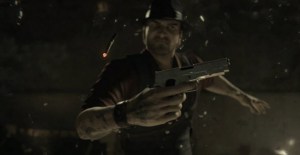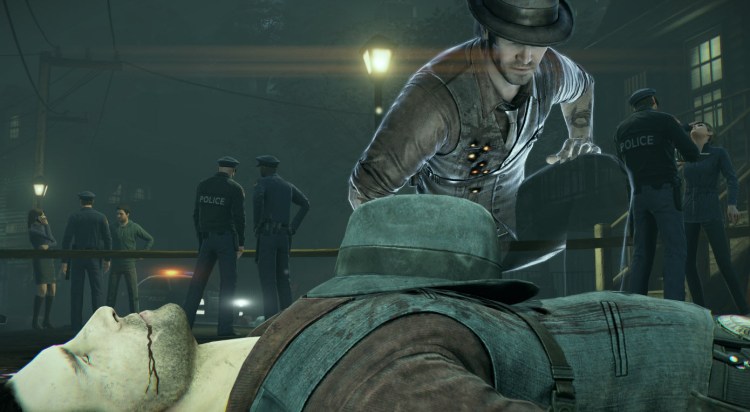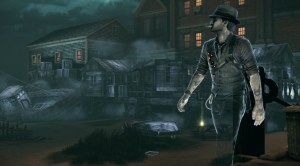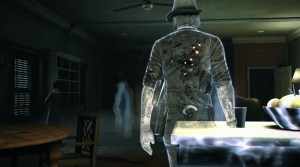GamesBeat: For that to work, it seems like you needed to put in some visual cues to help out. You don’t necessarily go through every single wall. You can go through the walls with the ghostly shimmer to them.
Brunner: Fundamentally, the consecrated walls, the exterior walls of buildings—because the town does have this history of supernatural almost-paranoia, they’ve gone to some extra lengths to consecrate their buildings against evil spirits. That just had the natural effect of preventing ghosts from freely passing in and out of them. But the interiors are fair game for moving about.
In many ways, that one simple rule set is all we really needed. In the afterlife world, too, the Dusk is also physical to you as a ghost, and not physical to human beings. They’ll all walk right through a car. But if that car is part of a past event that was rather traumatic and ended up in the afterlife world, then you can’t just go right through it. It’s solid to you.
GamesBeat: There’s a good mixture there of a closed, single-path narrative experience and something that’s more like an open world, where you can go in any direction or pursue different parts of the story.
Brunner: It’s weirdly freeing. It was unexpected to us, how freeing it was to be able to run through a space which normally would, at first glance, feel like something where you’d seen it all and knew it all. All of a sudden, if you can just pass through any door, any closet, any bathroom, in any order, it becomes a very different physical relationship puzzle.
GamesBeat: So you’re solving a mystery, solving each puzzle along the way. Again, it looks like there are lots of visual cues for people on how to learn to do that.
Brunner: Yeah. At the very beginning of the game, we try to walk you through it in a sort of seamless fashion, so that you understand the rules of the world intuitively. We don’t want to lay out the rules ahead of time on a sheet of paper and say, “Here’s what this place is.” We slowly introduce it to you so you understand, “Oh, I can walk through walls. Wait, I can’t walk through this one, but here’s why. This looks slightly different. That’s what’s going on here. I can’t talk to a human being, but I can possess them.” And so on.
GamesBeat: Last year, you didn’t have a lot of the cinematics in place, so that’s been new. The women in the story have come to the fore a lot more, very early on. Was it part of your effort to make a game that was as interesting to women as men, your sort of core male gamer?
Brunner: Yeah, I guess the core gaming audience has been mostly male. But that’s changing very quickly. Good storytelling is going to appeal to everyone. That’s our goal. We have quite a few women working on our team, as writers and environment artists and animators. We have a healthy balance there. It does begin to bubble up into the production, just helping us to keep things narratively strong, and not necessarily in a male-dominated way.
GamesBeat: It made a difference in how I perceived this character. He seemed like this sort of inexplicably tough, don’t-give-a-damn character last year, but now he has this romantic connection, which wasn’t there before. It makes him seem a little more human. You understand his motivations better.
Brunner: It’s also a motivation for getting the hell out of there. [Laughs]
GamesBeat: Beyond just, “Why did this happen to me?”
Brunner: Exactly.
 GamesBeat: It sounds like that’s always been part of this story.
GamesBeat: It sounds like that’s always been part of this story.
Brunner: It definitely has. It’s been part of the story development from the beginning. A game that has just one motivational thread is usually pretty shallow. A mystery in particular needs to have a lot of threads for it to sustain over many hours of gameplay. Mysteries are tough to write to begin with, because if one little moment gets yanked out at any particular point, it begins to fall apart. It takes a careful construction process to get from beginning to end.
GamesBeat: The pattern seems to be that you have a critical path – solving this one particular story – and then you have all these side-quests. But you have to collect clues for everything in order to be able to proceed and know if you’ve covered it all. At that point you have a choice of whether to use some of these clues to pursue the side-quests. Do the side-quests help at all as far as solving the critical mystery?
Brunner: No, they’re purely side-quests. You don’t have to play them. But they make you part of the world if you do. Honestly, if you just wanted to chase through the game and only do the main route, you’d be selling yourself short on the experience by quite a bit.
First of all, many of the ghosts that you encounter within the game are not on the main path. Getting to experience that other world with people who have already been stuck there for some time is really interesting. It’s much more dynamic.
GamesBeat: The great thing about being a ghost is that you get to be a voyeur.
Brunner: Exactly. [Laughs] We’re not going to push that to its limit.
GamesBeat: You can find out what people are thinking, too. I thought it was interesting that you could influence what they’re thinking.
Brunner: That takes a minute for people to see through. “Oh, maybe I can push this a bit further? Maybe I can get someone to give me some more information.” Using your influence, you can do that.
GamesBeat: It feels as if one lever you have for controlling this is just how difficult to make each puzzle — how many clues you have to find and that kind of thing.
Brunner: Not all clues are always necessary. You do have to find the important ones to be able to follow something all the way through, but if you feel like you want to give it a stab early and leap over the edge, you can do it. If you go, “Aw, I haven’t found them all,” you can dive back in and explore some more and find what you need.
GamesBeat: And if you guess right, do you get a better achievement score?
Brunner: Yes. Guessing right is definitely rewarded. Although we wouldn’t call it “guessing,” exactly. Call it a deduction, based on how you read the events that have transpired.
GamesBeat: The combat is also interesting. I don’t know if you even need to call it combat.
Brunner: I don’t think of it as combat at all. We didn’t want to turn this into a combat-focused game. Early on in development, we did have some true combat, and it began to feel too magical, if that makes sense. It began to feel like you were a sort of ghost Harry Potter. It felt like it was not within the parameters of the fiction that we wanted to develop.
Making it a dangerous world—You have to be cautious and careful about that. Having a number of tools that you can use either offensively or defensively began to make a lot more sense to us. We developed it a lot more around that idea, rather than a simple combat scenario. Yes, there are enemies. You do have some scary enemy encounters. But we’re not turning this game into a combat session




